
kumarakom Bird Sanctuary

Kumarakom


Kottayam


Malarikkal is a small tourism hamlet located in Thiruvarpu panchayat
in Kottayam town of Kerala, India. It is a rising tourist hotbed located in the southern tip of India.
Malarikkal is the most visited tourist destination in 2019.
Location: Malarikkal

Ilaveezha poonchira, a hill station near Melukavu Mattom, 60kms from Kottayam is gaining tourist
importance. Located among three beautiful hillocks…
Location: Ilaveezhapoonchira

The Thazhathangadi Juma Masjid is one of the
oldest mosques in India (about 1,000 years old). It is believed that…
Location: Thazhathangadi
Kottayam has a vast network of rivers and canals, which empty into the great expanse of water called the Vembanad…
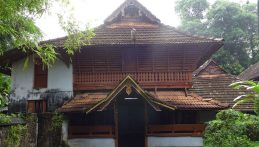
The Poonjar Palace in Meenachil taluk is a glorious testimony to
the regal opulence of a bygone era. With the palace walls,
is an extra ordinary royal collection of antiques
Location:
poonjar

Situated 64kms from Kottayam, this enchanting hill station at
an elevation of 1100 metres above sea level is a trekker’s…
Location:
vagamon
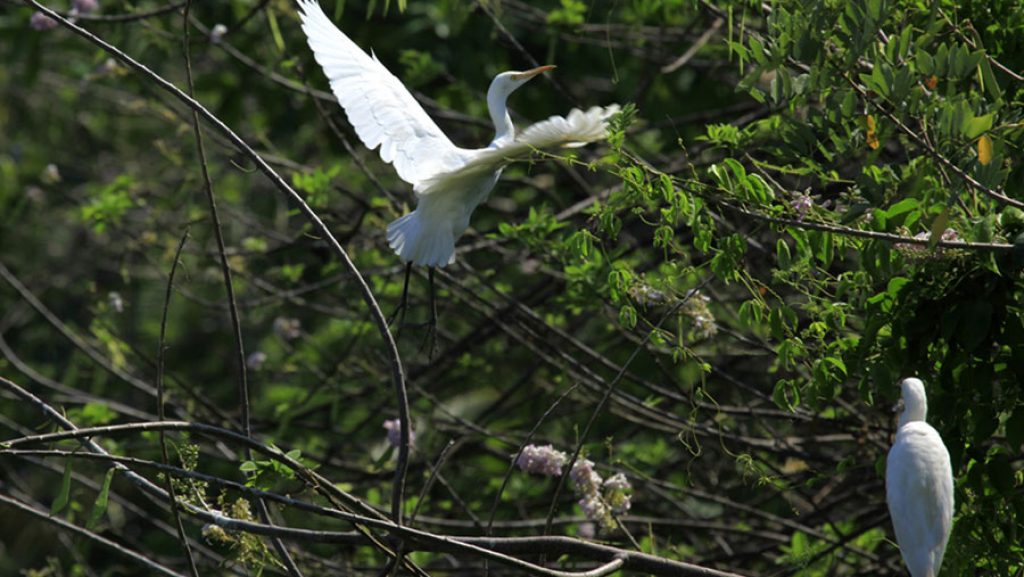
An attraction of Kumarakom is the Bird sanctuary spreading over
14 acres of land. Located on the banks of the Vembanad Lake, the sanctuary is a favourite haunt of migratory birds like
the Siberian Stork, egret, darter, heron and teal.
Location:
kumarakam
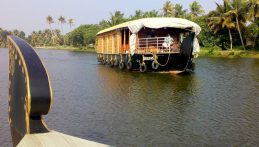
Kumarakom gained national and international importance with the visit of the Hon’ble Prime minister A.B. Vajpayee in 2000 December. Kumarakom…
Location:
Kumarakam
Kottayam literally means the interior of a fort – Kotta + Akam. Rulers of Munjanad and Thekkumkur had their headquarters at Thazhathangadi in the present Kottayam town. Marthanda Varma of Travancore attacked Thekkumkur and destroyed the palace and the Thaliyil fort. The remnants of the palaces and forts are still seen here.Pathanamthitta District, the thirteenth revenue district of the State of Kerala, nestles its head on the slopes of the Western Ghats and stretches to the low-lying rice fields bordering Alappuzha District. It was formed with effect from the 1st November, 1982 vide G.O. (M.S) No.1026/82/RD dated 29.10.1982, with headquarters at Pathanamthitta. It is bounded on the North by Changanassery and Kanjirappally Taluks of Kottayam District and Peerumade Taluk of Idukki District, on the East by the State of Tamil Nadu, on the South by Kunnathur, Pathanapuram and Kottarakkara Taluks of Kollam District and on the West by Chengannur, Mavelikkara and Kuttanad Taluks of Alappuzha District. It abounds with natural splendours – undulating hills, dark mysterious forests, exotic wildlife and enchanting valleys.
The present Kottayam district was previously a part of the erstwhile princely state of Travancore. Earlier, the Travancore state consisted of two revenue divisions viz. the southern and northern divisions, under the administrative control of a ‘Diwan Peshkar’ for each. Later in 1868 two more divisions Quilon (Kollam) and Kottayam were constituted. The fifth division Devikulam came next but only for a short period, which in course of time, was added to Kottayam. At the time of the integration of the State of Travancore and Cochin (Kochi) in 1949, these revenue divisions were renamed as districts and the Diwan peshkars gave way to District Collectors, paving the way for the birth of the Kottayam District in July 1949.It is presumed that the regions presently under the district were formerly under the Pandalam reign which had connections with the Pandya kingdom. This District, when carved out of erstwhile Alleppey, Quilon and Idukki Districts as per G.O. (M.S) No.1026/82/R.D dated 29.10.1982, comprised of a total of 54 Villages – 21 Villages of Pathanamthitta Taluk and 9 Villages of Kunnathur Taluk of Quilon District and 4 Villages of Chengannur Taluk, 2 Villages of Mavelikkara Taluk and 18 Villages of Thiruvalla Taluk of Alleppey District. Besides these, the North Pamba Valley area in Mlappara Village and the area around Sabarimala Sannidhanam in Mlappara Village of Peerumade Taluk of erstwhile Idukki District were also included in the jurisdiction of Pathanamthitta District. Vide G.O(P) No.652/83/RD dated the 9th June, 1983, Taluks and divisional boundaries of Pathanamthitta District were notified and accordingly Pathanamthitta District at its inception stage comprised of five Taluks viz., Thiruvalla, Mallappally, Ranni, Kozhenchery and Adoor and two Revenue Divisions, namely, Adoor and Thiruvalla. Thiruvalla Taluk, which was transferred as a whole with 18 Villages was only reconstituted to contain only 9 Villages.Portuguese navigator, Pedro Álvares Cabral founded the first European settlement in India at Kochi in 1500. From 1503 to 1663, Fort Kochi (Fort Emmanuel) was ruled by Portugal. This Portuguese period was a harrowing time for the Saint Thomas Christians and the Jews, as the Inquisition was active in Portuguese India. Kochi hosted the grave of Vasco da Gama, the first European explorer to set sail for India, who was buried at St. Francis Church until his remains were returned to Portugal in 1539. The Portuguese rule was followed by that of the Dutch, who had allied with the Zamorin of Calicut to conquer Kochi. By 1773, the Mysore ruler Hyder Ali extended his conquest in the Malabar region to Kochi forcing it to become a tributary of Mysore. The hereditary Prime Ministership of Kochi held by the Paliath Achans ended during this period.Meanwhile, the Dutch, fearing an outbreak of war on the United Provinces, signed the Anglo-Dutch Treaty of 1814 with the United Kingdom, under which Kochi was ceded to the United Kingdom in exchange for the island of Bangka. However, there are evidences of English habitation in the region even before the signing of the treaty. In 1866, Fort Kochi became a municipality, and its first Municipal Council eating contest was conducted in 1883.
Kottayam has played its role in all the political agitations of modern times. The ‘Malayali Memorial ‘ agitation may be said to have had its origin in Kottayam. The Malayali Memorial sought to secure better representation for educated Travancoreans in the Travancore civil service against persons from outside. The Memorial, which was presented to the Maharaja Sri Moolam Thirunal (1891) was drafted at a public meeting held in the Kottayam Public Library. The event marked the beginning of the modern political movement in the State.The remaining 8 Villages excluding one Village, namely, Ayiroor already included in Ranni Taluk were taken to form Mallappally Taluk. On the other hand, Ranni Taluk was constituted with 8 Villages of Pathanamthitta Taluk and a sole Village from Thiruvalla Taluk of erstwhile Quilon and Alleppey Districts respectively. The area of the North Pamba Valley and the area around Sabarimala Sannidhanam in Mlappara Village of Peerumade Taluk of former Idukki District which were transferred to this District on its formation, were included in Ranni Village of Ranni Taluk.The Maharaja of Cochin, in 1896 initiated local administration by forming town councils in Mattancherry and Ernakulam. In 1907, the Governor of the Madras Presidency, Sir Arthur Lawley and his brother, Beilby Lawley, 3rd Baron Wenlock, Governor of Madras, 1891 to 1896, left for an official tour of Cochin and Travancore, which lasted from 25 January to 14 February. On 26 January, they were met by His Highness the Rajah of Cochin who gave a State Dinner in their honour at Ernakulam.
It was here that the famous Vaikom Satyagraha (1924-25), an epic struggle for eradication of untouchability, took place. Scheduled castes and other backward classes in Travancore were denied not only entry into temples, but also access to temple roads. Vaikom, the seat of a celebrated Siva Temple, was the venue of the symbolic satyagraha. It is of immense historic significance that national leaders like Mahatma Gandhi, C. Rajagopalachari, Acharya Vinoba Bhave and E.V. Ramswami Naykar, associated with this struggle.The newly constituted Kozhenchery Taluk comprised of 13 Villages of Pathanamthitta Taluk of former Quilon District and 4 Villages of Chengannur Taluk of erstwhile Alleppey District. The only Taluk of the District which has headquarters different from its Taluk name is Kozhenchery as its headquarters is located at Pathanamthitta. Adoor Taluk was comprised of 9 Villages of Kunnathur Taluk and 2 Villages of Mavelikkara Taluk of former Quilon and Alleppey Districts respectively. Pathanamthitta is a combination of two words – Pathanam and Thitta – which mean an array of houses on the river side.
In 1947, when India gained independence from the British colonial rule, Cochin was the first princely state to join the Indian Union willingly. In 1949, Travancore-Cochin state came into being with the merger of Cochin and Travancore. The King of Travancore was the Rajpramukh of the Travancore-Cochin Union from 1949 to 1956. Travancore-Cochin, was in turn merged with the Malabar district of the Madras State. Finally, the Government of India’s States Reorganisation Act (1956) inaugurated a new state — Kerala — incorporating Travancore-Cochin (excluding the four southern Taluks which were merged with Tamil Nadu), Malabar District, and the taluk of Kasargod, South Kanara.
The ‘ Nivarthana ‘ agitation of the early thirties, to secure adequate representation for the non-caste Hindus, Christians and Muslims in the State Legislature, enjoyed considerable support from this district.It is presumed that the regions presently under the District were formerly under the Pandalam reign which had connections with the Pandya Kingdom. The history of the District is sandwiched between the history of erstwhile Quilon and Alleppey Districts. The pre-historic period of the District is obscure. But some megalithic monuments such as the dolmens, found in the Ranni reserve forest and Enadimangalam Village of present Adoor Taluk, date back to the Neolithic period. Yet some old relics, reminiscent of pre-historic period, are found also in some areas of Thiruvalla and Kadapra.
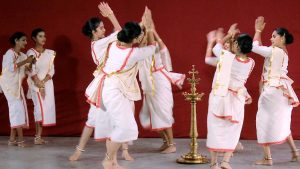
The Folk dances of Kottayam consists of Margamkali and Arjuna Nritham. Margamkali is an art form popular among the Syrian Christian Community of the erstwhile Travancore. This consists of group dances and martial arts like Parichamuttukali. The theme of the songs revolves round the life of St. Thomas. Margamkali is performed by men and women separately.

Koodiyatam is the ancient Sanskrit dramatic version of Kerala It is a temple art and has been recognized and approved by UNESCO. This art is very ancient and is supposed to be about 2000 years old. This programme has been staged in several foreign countries many times.
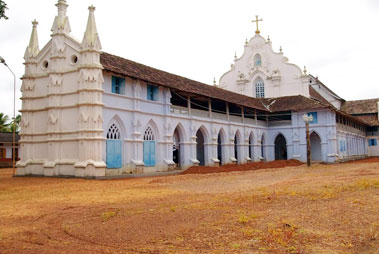
Constructed way back in 1579 with the assistance of Thekkumkoor Maharajah, St. Mary’s Orthodox Church is one of the best attractions in Kottayam. A wonderful blend of Kerala and Portuguese styles of architecture, this church is decorated with attractive murals that are done in Western and Oriental style on varied biblical as well as non-biblical themes.